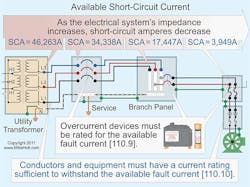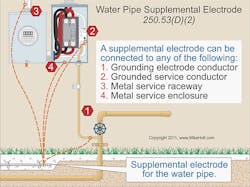All questions and answers are based on the 2011 NEC.
Q. What is the Code requirement for the interrupting protection rating of overcurrent devices?
A. Overcurrent devices, such as circuit breakers and fuses, are intended to interrupt the circuit, and they must have an interrupting rating not less than the nominal circuit voltage and the current that’s available at the line terminals of the equipment [110.9]. See the definition of “Interrupting Rating” in Art. 100. Unless marked otherwise, the ampere interrupting rating for circuit breakers is 5,000A [240.83(C)], and for fuses it’s 10,000A [240.60(C)(3)].
Available short circuit current is the current, in amperes, available at a given point in the electrical system. This available short circuit current is first determined at the secondary terminals of the utility transformer. Thereafter, the available short circuit current is calculated at the terminals of service equipment, then at branch circuit panelboards and other equipment. The available short circuit current is different at each point of the electrical system. It’s highest at the utility transformer and lowest at the branch circuit load. The available short circuit current depends on the impedance of the circuit. The greater the circuit impedance (utility transformer and the additive impedances of the circuit conductors), the lower the available short circuit current, as shown in Fig. 1.
The factors that affect the available short circuit current at the utility transformer include the system voltage, the transformer kVA rating, and the circuit impedance (expressed in a percentage on the equipment nameplate). Properties that have an impact on the impedance of the circuit include the conductor material (copper versus aluminum), conductor size, conductor length, and motor-operated equipment supplied by the circuit.
Many people in the industry describe Amperes Interrupting Rating (AIR) as “Amperes Interrupting Capacity” (AIC).
Danger: Extremely high values of current flow (caused by short circuits or ground faults) produce tremendously destructive thermal and magnetic forces. Overcurrent protection devices not rated to interrupt the current at the available fault values at its listed voltage rating can explode while attempting to open the circuit overcurrent device from a short circuit or ground fault, which can cause serious injury or death, as well as property damage.
Q. Where is NM cable allowed to be installed per the NEC?
A. Type NM and Type NMC cables can be used in the following [334.10] locations:
• One- and two-family dwellings of any height and their attached/detached garages or storage buildings [334.10(1)]
• Multifamily dwellings permitted to be of Types III, IV, and V construction [334.10(2)]
• Other structures permitted to be of Types III, IV, and V construction, except as prohibited in 334.12. Cables must be concealed within walls, floors, or ceilings that provide a thermal barrier of material with at least a 15-min. finish rating, as identified in listings of fire-rated assemblies [334.10(3)]. See the definition of “concealed” in Art. 100.
Note 1: Building constructions are defined in NFPA 220-2006, Standard on Types of Building Construction, the applicable building code, or both.
Note 2: See Annex E for the determination of building types [NFPA 220, Table 3-1].
Types NM and NMC cable are not permitted [334.12(A)] in the following locations:
• In any dwelling or structure not specifically permitted in 334.10(1), (2) and (3).
• Exposed in dropped or suspended ceilings in other than one- and two-family and multifamily dwellings.
• As service-entrance cable.
• In commercial garages having hazardous locations, as defined in 511.3.
• In theaters and similar locations, except where permitted in 518.4(B).
• In motion picture studios.
• In storage battery rooms.
• In hoistways, or on elevators or escalators.
• Embedded in poured cement, concrete, or aggregate.
• In any hazardous location, except where permitted by 501.10(B)(3), 502.10(B)(3), and 504.20.
Type NM cables must not be used under the following conditions or in the following locations [334.12(B)]:
• If exposed to corrosive fumes or vapors.
• If embedded in masonry, concrete, adobe, fill, or plaster.
• In a shallow chase in masonry, concrete, or adobe and covered with plaster, adobe, or similar finish.
• In wet or damp locations.
Type NM cable isn’t permitted in ducts or cavity plenum spaces [300.22], or for wiring in patient care areas [517.13].
Q. When does the NEC require a grounding electrode to have a supplemental electrode, and what are the installation rules?
A. A single rod, pipe, or plate electrode must be supplemented by an additional electrode that’s bonded to one of the following [250.53(A)(2)]:
• The single rod, pipe, or plate electrode
• The grounding electrode conductor of the single electrode
• The neutral service-entrance conductor
• The nonflexible grounded service raceway
• The service enclosure.
Exception: If a single rod, pipe, or plate grounding electrode has an earth contact resistance of 25 ohms or less, then the supplemental electrode isn’t required.
The supplemental electrode for a single rod, pipe, or plate electrode must be installed not less than 6 ft from the single electrode [250.53(A)(3)]. Note: The efficiency of paralleling electrodes is improved by spacing them at least twice the length of the longest rod.
When an underground metal water pipe grounding electrode is present [250.52(A)(1)], it must be supplemented by one of the following electrodes [250.53(D)(2)]:
• Metal frame of the building/structure electrode [250.52(A)(2)]
• Concrete-encased electrode [250.52(A)(3)]
• Ground ring electrode [250.52(A)(4)]
• Ground rod electrode meeting the requirements of 250.52(A)(5)
• Other listed electrodes [250.52(A)(6)]
• Metal underground systems, piping systems, or underground tanks [250.52(A)(8)]
The termination of the supplemental grounding electrode conductor must be to one of the following locations [250.53(D)(2)], as shown in Fig. 2:
• Grounding electrode conductor
• Service neutral conductor
• Metal service raceway
• Service equipment enclosure.
Exception: The supplemental electrode is permitted to be bonded to interior metal water piping located not more than 5 ft from the point of entrance to the building/structure [250.68(C)(1)].
The grounding electrode conductor to a ground rod that serves as a supplemental electrode isn’t required to be larger than 6 AWG copper [250.53(E)].
Q. What is the NEC requirement about bonding around water meters?
A. A bonding jumper must be installed around insulated joints and equipment likely to be disconnected for repairs or replacement for an underground metal water piping system used as a grounding electrode. The bonding jumper must be of sufficient length to allow the removal of such equipment while retaining the integrity of the grounding path [250.68(B)].
Q. What is the Code requirement in regard to installing receptacles with insulated grounding terminals in patient care areas?
A. Receptacles having insulated grounding terminals (isolated ground receptacles) [250.146(D)] aren’t permitted to be installed in patient care areas [517.16].
About the Author

Mike Holt
Mike Holt is the owner of Mike Holt Enterprises (www.MikeHolt.com), one of the largest electrical publishers in the United States. He earned a master's degree in the Business Administration Program (MBA) from the University of Miami. He earned his reputation as a National Electrical Code (NEC) expert by working his way up through the electrical trade. Formally a construction editor for two different trade publications, Mike started his career as an apprentice electrician and eventually became a master electrician, an electrical inspector, a contractor, and an educator. Mike has taught more than 1,000 classes on 30 different electrical-related subjects — ranging from alarm installations to exam preparation and voltage drop calculations. He continues to produce seminars, videos, books, and online training for the trade as well as contribute monthly Code content to EC&M magazine.


